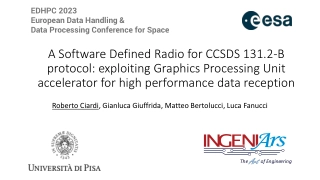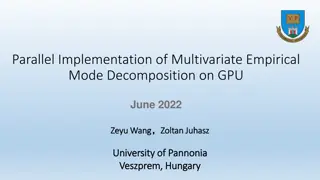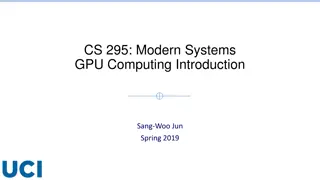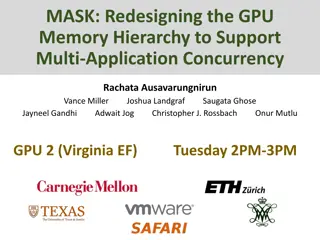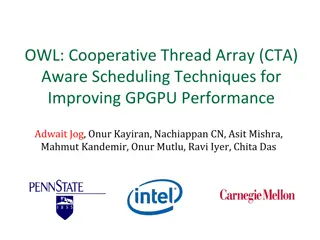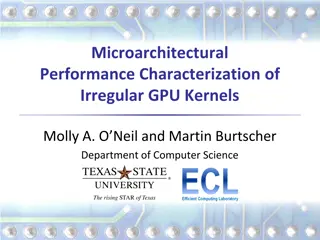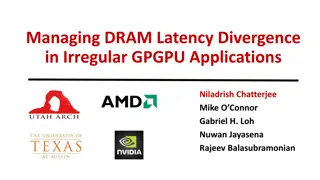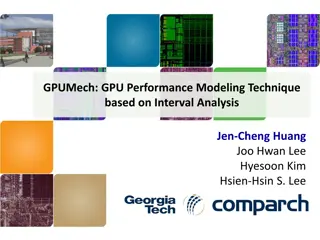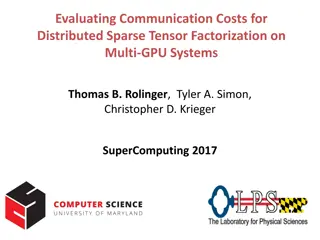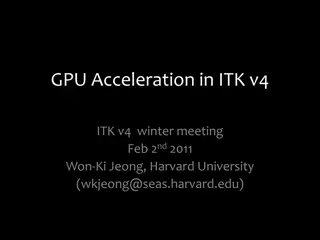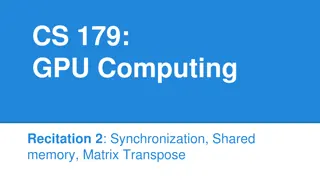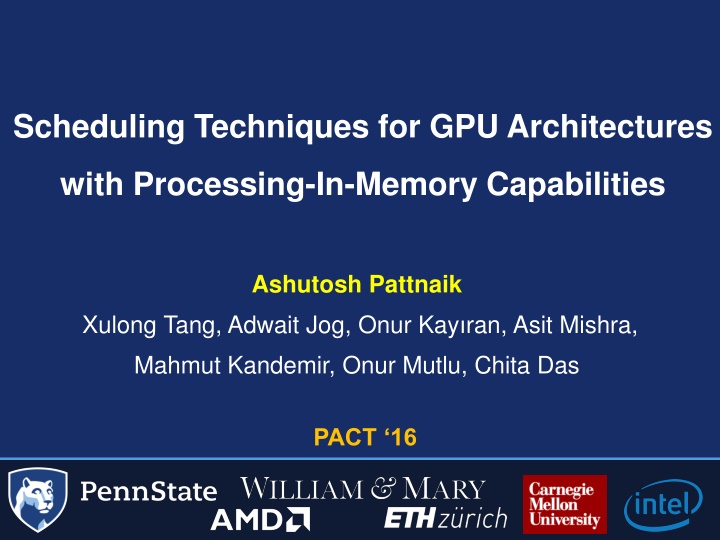
Techniques for GPU Architectures with Processing-In-Memory Capabilities
Explore scheduling techniques for GPU architectures with processing-in-memory capabilities to enhance energy efficiency and performance. Delve into the challenges, advancements, and future prospects in the era of energy-efficient architectures. Identify bottlenecks such as off-chip transactions affecting system efficiency. Additionally, examine normalized performance metrics and the utilization of Processing-In-Memory (PIM) to reduce data movement in GPU operations.
Download Presentation

Please find below an Image/Link to download the presentation.
The content on the website is provided AS IS for your information and personal use only. It may not be sold, licensed, or shared on other websites without obtaining consent from the author. If you encounter any issues during the download, it is possible that the publisher has removed the file from their server.
You are allowed to download the files provided on this website for personal or commercial use, subject to the condition that they are used lawfully. All files are the property of their respective owners.
The content on the website is provided AS IS for your information and personal use only. It may not be sold, licensed, or shared on other websites without obtaining consent from the author.
E N D
Presentation Transcript
Scheduling Techniques for GPU Architectures with Processing-In-Memory Capabilities Ashutosh Pattnaik Xulong Tang, Adwait Jog, Onur Kay ran, Asit Mishra, Mahmut Kandemir, Onur Mutlu, Chita Das PACT 16 Scheduling Techniques for GPU Architectures with Processing-In-Memory Capabilities
Era of Energy-Efficient Architectures Peak Performance increased by ~27x in past 6 years Energy Efficiency increased by ~7x in past 6 years Future: 1 ExaFlops/s at 20 MW Peak power Greatly need to improve energy efficiency as well as performance! 2010: Tianhe-1A 4.7 PFlop/s, 4 MW ~1.175 TFlops/W 2013: Tianhe-2 2016: Sunway TaihuLight 125.4 PFlop/s, 15.4 MW ~8.143 TFlops/W 54.9 PFlop/s, 17.8 MW ~3.084 TFlops/W 2 Scheduling Techniques for GPU Architectures with Processing-In-Memory Capabilities
Bottleneck Continuous energy-efficiency and performance scaling is not easy. Energy consumed by a floating-point operation is scaling down with technology scaling. Energy consumption due to data transfer overhead is not scaling down! 3 Scheduling Techniques for GPU Architectures with Processing-In-Memory Capabilities
Bottleneck Off-Chip Transactions Off-Chip Energy 1 0.8 0.6 Fraction Across these 25 GPGPU applications: 49% of all transactions are off-chip. This is responsible for 41% of total energy consumption of the system. 0.4 0.2 0 Data movement and system energy consumption caused by off-chip memory accesses. 4 Scheduling Techniques for GPU Architectures with Processing-In-Memory Capabilities
Bottleneck 1 Normalized Performance 0.8 0.6 0.4 Main memory accesses lead to 45% performance degradation! 0.2 0 Performance normalized to a hypothetical GPU where all the off-chip accesses hit in the last-level cache. 5 Scheduling Techniques for GPU Architectures with Processing-In-Memory Capabilities
Outline Introduction and Motivation Background and Challenges Design of Kernel Offloading Mechanism Design of Concurrent Kernel Management Simulation Setup and Evaluation Conclusions 6 Scheduling Techniques for GPU Architectures with Processing-In-Memory Capabilities
Revisiting Processing-In-Memory (PIM) It s a promising approach to minimize data movement. The concept dates back to the late 1960s Technological limitations of integrating fast computational units in memory was a challenge Significant advances in adoption of 3D-stacked memory has enabled tight integration of memory dies and logic layer brought computational units into the memory stack 7 Scheduling Techniques for GPU Architectures with Processing-In-Memory Capabilities
PIM-Assisted GPU architecture We integrate PIM units to a GPU based system and we call this as PIM-Assisted GPU architecture . At least one 3D-stacked memory is integrated with PIM units and is placed adjacent to a traditional GPU design. 8 Scheduling Techniques for GPU Architectures with Processing-In-Memory Capabilities
PIM-Assisted GPU architecture Traditional GPU architecture* Memory Memory Link GPU * Only a single DRAM partition is shown for illustration purposes 9 Scheduling Techniques for GPU Architectures with Processing-In-Memory Capabilities
PIM-Assisted GPU architecture GPU architecture with 3D-stacked memory on a silicon interposer Memory Dice Memory Link on Interposer GPU Silicon Interposer 10 Scheduling Techniques for GPU Architectures with Processing-In-Memory Capabilities
PIM-Assisted GPU architecture Now we add a logic layer to the 3D-stacked memory and we call this logic layer as GPU-PIM. The traditional GPU logic is now called GPU-PIC. 3D Stacked Memory and Logic Memory Dice GPU-PIM Memory Link on Interposer GPU-PIC Silicon Interposer 11 Scheduling Techniques for GPU Architectures with Processing-In-Memory Capabilities
PIM-Assisted GPU architecture Application can now be run on both GPU-PIC and GPU-PIM Challenge: Where to execute the application on? 3D Stacked Memory and Logic Memory Dice GPU-PIM Memory Link on Interposer GPU-PIC Silicon Interposer 12 Scheduling Techniques for GPU Architectures with Processing-In-Memory Capabilities
Application Offloading We evaluate application execution on either GPU-PIC or GPU-PIM GPU-PIC GPU-PIM Best Application Offloading 2.64 2.46 1.5 Normalized IPC 1.3 1.1 0.9 0.7 Optimal application offloading scheme provides 16% and 28% improvements in performance and energy efficiency, respectively. 0.5 GPU-PIC GPU-PIM 2.50 Best Application Offloading 2.60 1.5 2.51 5.95 2.64 2.1 Normalized Energy 1.3 (Inst./Joule) 1.1 Efficiency 0.9 0.7 0.5 13 Scheduling Techniques for GPU Architectures with Processing-In-Memory Capabilities
Limitations of Application Offloading Limitation 1: Lack of Fine-Grained Offloading FDTD 14 Scheduling Techniques for GPU Architectures with Processing-In-Memory Capabilities
Limitations of Application Offloading Limitation 1: Lack of Fine-Grained Offloading Running K1 on GPU-PIM, and K2 and K3 on GPU-PIC provides the optimal kernel placement for improved performance. 15 Scheduling Techniques for GPU Architectures with Processing-In-Memory Capabilities
Limitations of Application Offloading Limitation 1: Lack of Fine-Grained Offloading Limitation 2: Lack of Concurrent Utilization of GPU-PIM and GPU- PIC GPU-PIC is idle! From the application we find that kernel K1 and K2 are independent from each other. 16 Scheduling Techniques for GPU Architectures with Processing-In-Memory Capabilities
Limitations of Application Offloading Limitation 1: Lack of Fine-Grained Offloading Limitation 2: Lack of Concurrent Utilization of GPU-PIM and GPU- PIC K1 K2 K3 Application Offloading GPU-PIM I GPU-PIC II Offloading GPU-PIM Scheduling kernels based on their affinity is very important to achieve higher performance. Kernel III A GPU-PIC FDTD Management Concurrent K1 -> GPU-PIC K2 -> GPU-PIM GPU-PIM Kernel IV B GPU-PIC Management Concurrent GPU-PIM V Kernel K1 -> GPU-PIM K2 -> GPU-PIC C GPU-PIC 0 0.2 0.4 0.6 0.8 1 1.2 Normalized Execution Time 17 Scheduling Techniques for GPU Architectures with Processing-In-Memory Capabilities
Our Goal To develop runtime mechanisms for automatically identifying architecture affinity of each kernel in an application scheduling kernels on GPU-PIC and GPU-PIM to maximize for performance and utilization 18 Scheduling Techniques for GPU Architectures with Processing-In-Memory Capabilities
Outline Introduction and Motivation Background and Challenges Design of Kernel Offloading Mechanism Design of Concurrent Kernel Management Simulation Setup and Evaluation Conclusions 19 Scheduling Techniques for GPU Architectures with Processing-In-Memory Capabilities
Design of Kernel Offloading Mechanism Goal: Offload kernels to either GPU-PIC or GPU-PIM to maximize performance Challenge: Need to know the architecture affinity of the kernels We build an architecture affinity prediction model 20 Scheduling Techniques for GPU Architectures with Processing-In-Memory Capabilities
Design of Kernel Offloading Mechanism Metrics used to predict compute engine affinity and GPU-PIC and GPU-PIM execution time. Category Predictive Metric Memory to Compute Ratio Number of Compute Inst. Number of Memory Inst. Number of CTAs Total Number of Threads Number of Thread Inst. Total Number of Shared Memory Inst. Static/Dynamic Static Static Static Dynamic Dynamic Dynamic I: Memory Intensity of Kernel II: Available Parallelism in the Kernel III: Shared Memory Intensity of Kernel Static 21 Scheduling Techniques for GPU Architectures with Processing-In-Memory Capabilities
Design of Kernel Offloading Mechanism Logistic Regression Model for Affinity Prediction ?? ?(?) = ??+ 1 where: ?(?) = model output (?(?) < 0.5 => GPU-PIC, ?(?) 0.5 => GPU-PIM) ? = ?0+ ?1?1+ ?2?2+ ?3?3+ ?4?4+ ?5?5+ ?6?6+ ?7?7 ?? = Coefficients of the Regression Model ?? = Predictive Metrics 22 Scheduling Techniques for GPU Architectures with Processing-In-Memory Capabilities
Design of Kernel Offloading Mechanism Training Set: we randomly sample 60% (15) of the 25 GPGPU applications considered in the paper. These 15 applications consists of 82 unique kernels that are used for training the affinity prediction model. Test Set: the remaining 40% (10) of the applications are used as the test set for the model Accuracy of the model on the test set: 83% 23 Scheduling Techniques for GPU Architectures with Processing-In-Memory Capabilities
Outline Introduction and Motivation Background and Challenges Design of Kernel Offloading Mechanism Design of Concurrent Kernel Management Simulation Setup and Evaluation Conclusions 24 Scheduling Techniques for GPU Architectures with Processing-In-Memory Capabilities
Design of Concurrent Kernel Management Goal: Efficiently manage the scheduling of concurrent kernels to improve performance and utilization of the PIM-Assisted GPU architecture For efficiently managing kernel execution on both GPU-PIM and GPU-PIC, we need Kernel-level Dependence Information Architecture Affinity Information Execution Time Information 25 Scheduling Techniques for GPU Architectures with Processing-In-Memory Capabilities
Design of Concurrent Kernel Management For efficiently managing kernel execution on both GPU-PIM and GPU-PIC, we need Kernel-level Dependence Information Obtained through exhaustive analysis to find RAW dependence for all considered applications and input pairs Architecture Affinity Information Execution Time Information 26 Scheduling Techniques for GPU Architectures with Processing-In-Memory Capabilities
Design of Concurrent Kernel Management For efficiently managing kernel execution on both GPU-PIM and GPU-PIC, we need Kernel-level Dependence Information Obtained through exhaustive analysis to find RAW dependence for all considered applications and input pairs Architecture Affinity Information Utilizes the affinity prediction model built for kernel offloading mechanism Execution Time Information 27 Scheduling Techniques for GPU Architectures with Processing-In-Memory Capabilities
Design of Concurrent Kernel Management For efficiently managing kernel execution on both GPU-PIM and GPU-PIC, we need Kernel-level Dependence Information Obtained through exhaustive analysis to find RAW dependence for all considered applications and input pairs Architecture Affinity Information Utilizes the affinity prediction model built for kernel offloading mechanism Execution Time Information We build linear regression models for execution time prediction on GPU-PIC and GPU-PIM We use the same Predictive metrics and training set used for affinity prediction model 28 Scheduling Techniques for GPU Architectures with Processing-In-Memory Capabilities
Design of Concurrent Kernel Management Linear Regression Model for Execution Time Prediction Model ? = ?0+ ?1?1+ ?2?2+ ?3?3+ ?4?4+ ?5?5+ ?6?6+ ?7?7 where: ? = model output (predicted execution time) ?? = Coefficients of the Regression Model ?? = Predictive Metrics 29 Scheduling Techniques for GPU Architectures with Processing-In-Memory Capabilities
Design of Concurrent Kernel Management Lets run through an example GPU-PIC Queue GPU-PIM Queue K7 GPU-PIM has no more kernels in its work queue to schedule K6 K5 K4 idle GPU-PIM is currently idle GPU-PIC is currently executing kernel K4 30 Scheduling Techniques for GPU Architectures with Processing-In-Memory Capabilities
Design of Concurrent Kernel Management We can potentially pick any kernel (assuming no data dependence among themselves and K4) from GPU-PIC Queue and schedule them onto GPU-PIM GPU-PIC Queue GPU-PIM Queue K7 K6 K5 K4 idle GPU-PIM is currently idle GPU-PIC is currently executing kernel K4 But which one to pick? 31 Scheduling Techniques for GPU Architectures with Processing-In-Memory Capabilities
Design of Concurrent Kernel Management We steal the first kernel that satisfies a given condition and schedule it on to GPU-PIM Queue. Pseudocode: time(kernel, compute_engine) returns the estimated execution time of kernel when executed on compute_engine Estimated execution time of currently executing kernel K4 on GPU-PIC for X in GPU-PIC s Queue ?? (???? ?,??? ??? { ???? ?4,??? ??? ????? ??? ?? ????? ? ?? ??? ???; ?????; ?????????????4 + ???? ?,??? ??? } 32 Scheduling Techniques for GPU Architectures with Processing-In-Memory Capabilities
Outline Introduction and Motivation Background and Challenges Design of Kernel Offloading Mechanism Design of Concurrent Kernel Management Simulation Setup and Evaluation Conclusions 33 Scheduling Techniques for GPU Architectures with Processing-In-Memory Capabilities
Simulation Setup Evaluated on GPGPU-Sim, a cycle accurate GPU simulator Baseline configuration 40 SMs, 32-SIMT lanes, 32-threads/warp 768 kB L2 cache GPU-PIM configuration 8 SMs, 32-SIMT lanes, 32-threads/warp No L2 cache GPU-PIC configuration 32 SMs, 32-SIMT lanes, 32-threads/warp 768 kB L2 cache 25 GPGPU Applications classified into 2 exclusive sets Training Set: The kernels are used as input to build the regression models Test Set: The regression models are only tested on these kernels 34 Scheduling Techniques for GPU Architectures with Processing-In-Memory Capabilities
Performance (Normalized to Baseline) Kernel Offloading (Dynamic) Concurrent Kernel Management (Dynamic) Kernel Offloading (Oracle) Concurrent Kernel Management (Oracle) 3 2.5 2 1.5 1 0.5 0 Training Set Test Set Performance improvement for Test Set applications Kernel Offloading = 25% Concurrent Kernel Management = 42% 35 Scheduling Techniques for GPU Architectures with Processing-In-Memory Capabilities
Energy-Efficiency (Normalized to Baseline) Kernel Offloading (Dynamic) Concurrent Kernel Management (Dynamic) Kernel Offloading (Oracle) Concurrent Kernel Management (Oracle) 3 2.5 2 1.5 1 0.5 0 More results and detailed description of our runtime mechanisms are in the paper. Training Set Test Set Energy-Efficiency improvement for Test Set applications Kernel Offloading = 28% Concurrent Kernel Management = 27% 36 Scheduling Techniques for GPU Architectures with Processing-In-Memory Capabilities
Conclusions Processing-In-Memory is a key direction in achieving high performance with lower power budget. Simply offloading applications completely onto PIM units is not optimal. For effective utilization of PIM-Assisted GPU architecture, we need to Identify code segments for offloading onto GPU-PIM Efficiently distribute work between GPU-PIC and GPU-PIM Our kernel-level scheduling mechanisms can be an effective runtime solution for exploiting processing-in-memory in modern GPU-based architectures. 37 Scheduling Techniques for GPU Architectures with Processing-In-Memory Capabilities
Scheduling Techniques for GPU Architectures with Processing-In-Memory Capabilities Ashutosh Pattnaik, Xulong Tang, Adwait Jog, Onur Kay ran, Asit Mishra, Mahmut Kandemir, Onur Mutlu, Chita Das. PACT 16 Scheduling Techniques for GPU Architectures with Processing-In-Memory Capabilities

